A compilation of the most memorable space weather moments of 2018 can be found underneath. Using the versatile JHelioviewer software, a ***MOVIE*** was created containing one or more clips of each event. Usually, SDO-images were used, occasionally supplemented with imagery from PROBA2, SOHO, GONG and STEREO.
As this chronological list concerns mostly punctual events on the Sun, it does not contain clips from other noteworthy events in 2018, such as e.g. the launch of the Parker Solar Probe (12 August).
Happy viewing!
Event 1: 8-9 January - High-latitude sunspot group NOAA 2694
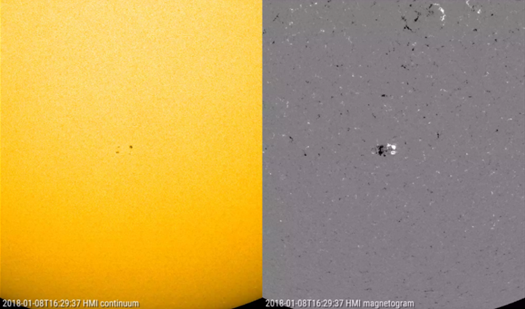
The first sunspot groups of a new solar cycle appear at high solar latitudes around 25-30 degrees and have a magnetic polarity opposite to that of the previous cycle. When in December 2016 a reversed polarity group appeared in the southern solar hemisphere at a latitude well beyond 20 degrees, it was considered to be the first group of the new solar cycle (SC25). No high-latitude regions were observed until 8 January 2018, when a small sunspot group NOAA 2694 appeared with a latitude of -32 degrees. That's a perfect latitude for a new cycle region, but... the region had the *same* magnetic polarity as the sunspot groups on the southern hemisphere of the *old* solar cycle (SC24). It currently looks like this region is indeed a genuine SC25 group which happens to have a reversed polarity (3 to 5 % of the groups in a solar cycle have a reversed polarity). Later in the year, groups at high latitudes with the correct (SC25) magnetic polarity appeared on both solar hemispheres, but they were too small or too short-lived to get a NOAA-number.
Ref: STCE news items of 9 January 2018, 11 April 2018, 16 July 2018, 28 August 2018, and 13 November 2018
Event 2: 22 January - Spectacular B9 flare in NOAA 2696
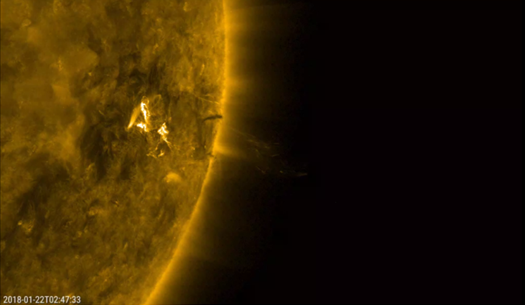
One of the more spectacular eruptions in 2018 occurred on 22 January in decaying active region NOAA 2696. The B9 flare was associated with a non-earth directed coronal mass ejection (CMEs) which had a projected speed of about 625 km/s (CACTus). CMEs were rare in 2018, with often no CME registered for weeks on end.
Ref: STCE Newsletter of 2 February 2018, and STCE news item of 27 March 2018
Event 3: 7-12 February - NOAA 2699: most flare-active group
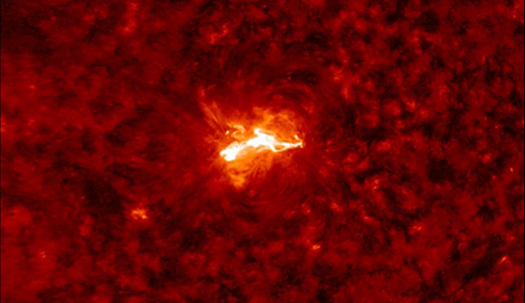
NOAA 2699 was the largest sunspot group in 2018, having a size of about 1.5 times the total surface area of the Earth. It produced 6 of the 11 recorded C-class flares in the year, with a C8.1 flare on 7 February being the strongest event. On 12 February, while the region was near disk-centre, it produced also a C1 long duration event (LDE) lasting more than 3 hours. The associated halo CME was weak and had a speed of about 500 km/s. Only active geomagnetic conditions were observed when it hit the earth environment 3 days later. No M- or X-class flares were recorded in 2018. There were also no proton events or Ground Level Enhancements reported. Of note were the 208 spotless days (SILSO) in 2018, with a 17-day stretch from 22 October till 7 November (preliminary values). These are typical values during (deep) solar cycle minimum years.
Ref: STCE news item of 13 February 2018, 24 July 2018, and 13 November 2018
Event 4: 30 April - 07 May - Large coronal hole
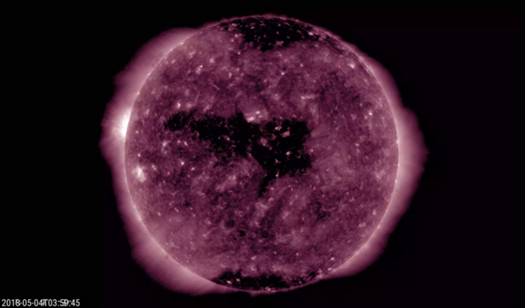
The compression region and high speed stream of a large elongated coronal hole prompted minor to moderate geomagnetic storming. Speeds up to 710 km/s were recorded. One solar rotation later (early June), the solar wind speed from the same coronal hole would reach even 785 km/s. These were the highest speeds recorded in 2018, and the only times they clearly superseded 700 km/s. The coronal hole itself developed from an extension of the southern polar coronal hole in November 2017, and lasted 9 solar rotations. From February till May, it had a remarkable elongated structure.
Ref: STCE news item of 17 April 2018
Event 5: 23-28 May - Resurgence of NOAA 2712
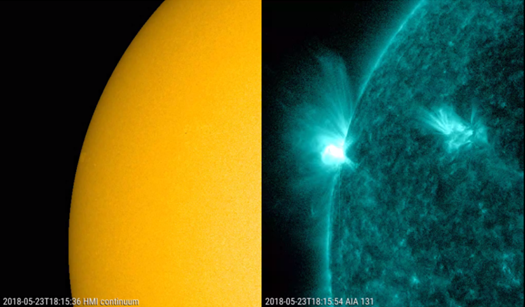
Before rounding the east limb, active region NOAA 2712 announced its presence well in advance as dynamic coronal loops were towering above the east limb more than 2 days before the sunspot group actually became visible. It produced also a C2 flare while it was just behind the solar limb. Once the region had come into view, it turned out to be a rather simple and decaying sunspot group. However, new magnetic flux emerged during the afternoon of 27 May, resulting in an increase of the number of sunspots. As there was also some mixed polarity involved in its trailing portion, a C2.7 flare was produced on 28 May.
Ref: STCE news item of 29 May 2018
Event 6: 20-21 August - Filament eruption leading to G3-storm on 26 August
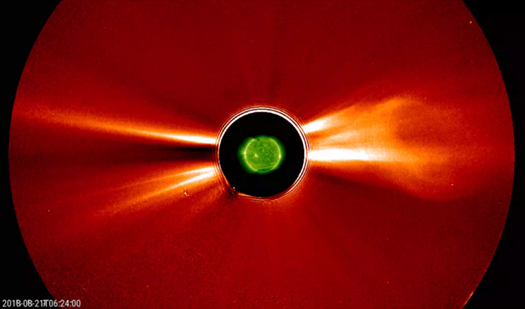
A modest filament eruption taking place on 20 August had an associated coronal mass ejection (CME) which was barely visible in SOHO's coronagraphs. In fact, the feature was so weak that CACTus, a tool to automatically detect CMEs in these coronagraphic images, did not even capture the CME. With the help of STEREO-A imagery, it was determined that this CME had an earth-directed component. As predicted, the ICME arrived at Earth on 26 August, but the ensuing geomagnetic storm was surprisingly intense, with Kp reaching strong levels (Kp = 7). The (Quicklook) Dst index (WDC Kyoto) reached -174 nT, making this the 3rd strongest storm of SC24. Geomagnetically induced currents were observed in Norway and about 10 times stronger than usual.
Ref: STCE news item of 28 August 2018
Event 7: 2-10 September - Small and large coronal hole
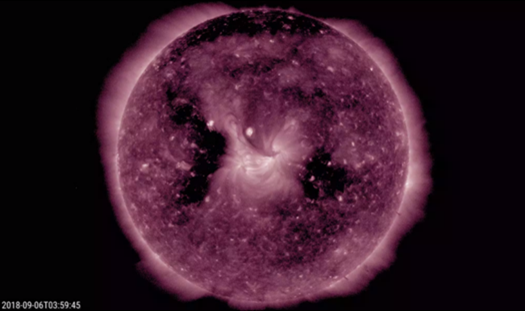
A small equatorial hole and an extension from the northern polar coronal hole transited the Sun early September. These coronal holes developed in July and remained visible till the end of the year. Minor to moderate geomagnetic storming levels were recorded and Dst reached -60 nT, the most intense of all co-rotating interaction region/high-speed stream pairs from coronal holes in 2018.
Ref: STCE Newsletter of 21 September 2018
Event 8: 25 October - Prominence eruption
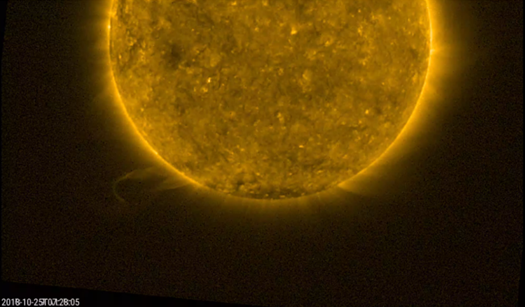
A prominence eruption was observed near the southeast solar limb on 25 October. The associated CME was very slow (less than 200 km/s) and was not directed to Earth. So close to the solar cycle minimum, even this kind of eruptions have become a rarity.
Ref: STCE Newsletter of 2 November 2018





